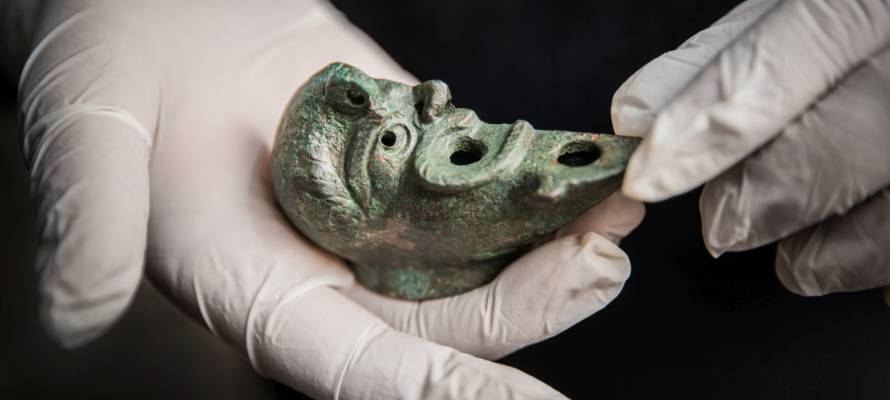“The uniqueness of the current object is that it is only half a face,” said Dr. Baruch, with researchers debating as to whether it actually served as a lamp or was used in some sort of ceremonial ritual.
By Yakir Benzion, United With Israel
A rare bronze oil lamp, shaped like a grotesque face that was cut in half, was uncovered in excavations in Jerusalem’s City of David National Park, the Israel Antiquities Authority announced Wednesday.
Archaeologists Ari Levy and Dr. Yuval Baruch believe that the lamp, discovered in the foundations of a building resting on Pilgrimage Road, was put there intentionally in order to bring good fortune to the building’s residents.
The special bronze lamp dates from the late-1st or early-2nd century CE during the Roman period following the destruction of Jerusalem and the Second Temple. It is thought to be a “foundation deposit” – a ritual burial of an offering in the foundations of a building.
“Foundation deposits were prevalent in the ancient world and were intended for luck and to ensure the continued existence of the building and its occupants, and they were usually buried under the floors of buildings or foundations,” explained Dr. Baruch.
The artifact is actually half-lamp, half-symbolic. It was poured into a sculpted mold that was shaped like half of a face of a bearded man with a grotesque appearance. The tip of the lamp is shaped like a crescent moon, and the handle is shaped like the Acanthus – a flowering plant native to the Mediterranean area. The decoration that appears on the lamp is reminiscent of a common Roman artistic motif, similar to a theatrical mask.
The architects say the lamp is a very unique find, and as far as they know, it is the first of its kind discovered in Israel.
“The uniqueness of the current object is that it is only half a face,” said Dr. Baruch, with researchers debating as to whether it actually served as a lamp or was used in some sort of ceremonial ritual.
“The building where the lamp was discovered was built directly on top of the Pilgrimage Road at the end of the Second Temple period,” said Dr. Levy. “The construction of such a massive structure in the period after the destruction of Jewish Jerusalem demonstrates the importance of the area even after the destruction of the Second Temple.”
“It is possible that the importance of the building, and the need to bless its activity with luck by burying a foundation deposit, was due to its proximity to the Siloam Pool, which was also used in the Roman period as the central source of water within the city,” Levy noted.
During the cleaning of the lamp no genie popped out, but a wick made of flax was discovered inside. It will be examined to see if any oil residue remains, which would help determine whether the lamp was used, and if so, what oil they used to light it.
“Decorated bronze oil lamps were discovered throughout the Roman Empire,” said Dr. Baruch. “For the most part, such oil lamps stood on stylish candelabras or were hung on a chain. Collections around the world contain thousands of these bronze lamps, many of which were made in intricate shapes, indicating the artistic freedom that Roman metal artists possessed.”
“This half of a lamp, and in fact half a face, which was discovered in the City of David, is a very rare object, with only a few discovered in the whole world, and is the first of its kind to be discovered in Jerusalem,” he said
REBUILD ISRAELI FARMS DESTROYED BY HAMAS - PLANT TREES!
ISRAELI FARMERS DESPERATELY NEED YOUR YOUR HELP
Hamas tried to destroy everything. Terrorists murdered 1200 innocent Israelis. Join us in planting 12,000 trees of life to honor the victims. Send blessing to the People and Land of Israel.
“…I will ordain My blessing for you…” (Leviticus 25:4,21)
JOIN OUR CAMPAIGN TO PLANT 12,000 NEW FRUIT TREES ACROSS THE LAND OF ISRAEL!




